Cards are the most important element of HOPE Cardgame. There are three card types – units, locations and events.
Game Rules
Playing Cards
Units
Units represent the player’s army that participates in battles against their opponent – they are either attacking or defending. Unit cards are therefore labeled ATTACK, DEFENSE and VITALITY.
Each unit also has special or passive abilities that increase their strength in the game. Besides battles, units can move around the battleground. Strategic movement is important especially in the Dominance
phase.
Locations
Locations are used for 4 purposes:
- They work as a shield that protects player’s units against the opponent and in addition block their units
- Expanding the base, because the player can play units around them
- Helping to control large areas of battleground, because in the Dominance phase locations have a greater relevance than units
- Providing special or passive abilities to players during the game
Locations are labeled DEFENSE and have a green border.
Events
Events are onetime effects which enter the game in different phases. These phases are defined by the flag on the card. In the event that the flag is labeled ANYTIME it can be played in any phase of the round.
After playing an event card its effect works immediately (see resolving abilities on page 7). After resolution, the event card is immediately moved to the player’s discard pile.
Events do not have any illustration and have a blue border.
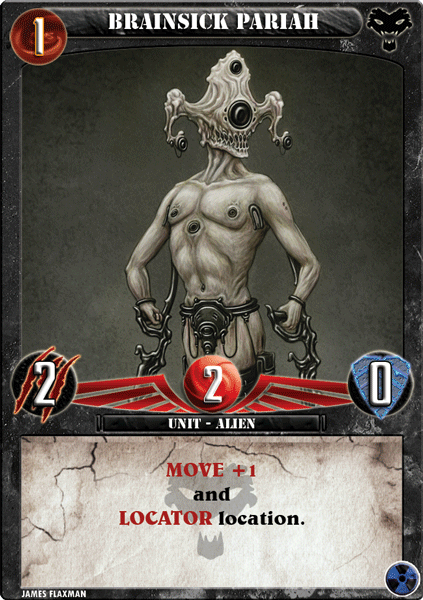
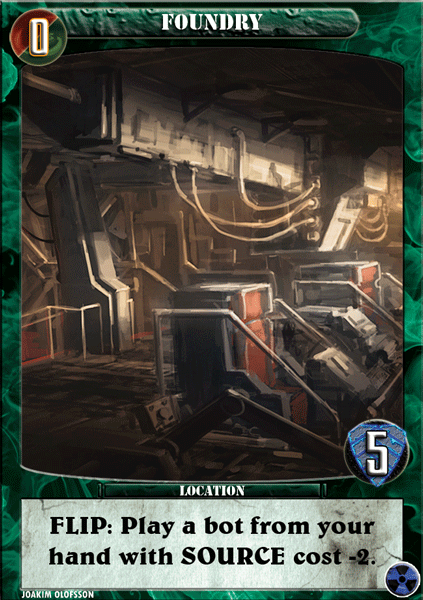
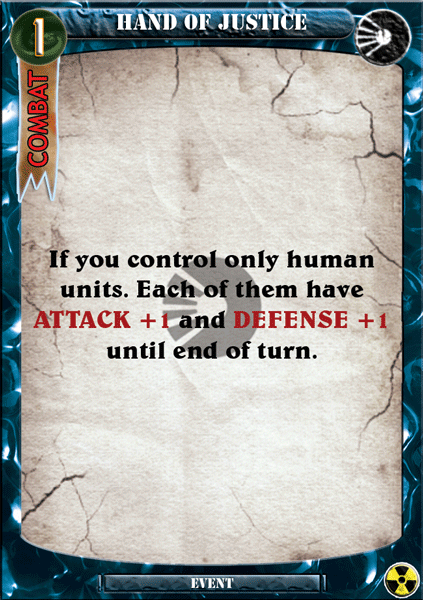
Card description
- Card cost: every card has its own price expressed by the number of sources (X). Depending on the underlying color of the number, the price has a different meaning:
- red: to play the card the player has to pay X sources
- green: for playing the card the player receives X sources
- red/green: playing the card does not cost any sources.
- Name: name of the card. The symbol “•” indicates unique cards. Each player can have only one copy of each unique card active on the battleground. Duplicate card can be played at the moment when the current unique card is removed from the battleground and moved to the discard pile or back of the hand.
- Card type: unit, location, event.
- Symbol
- Race: icon indicating the nationality of unit to the race, which is also indicated by the card background.
- Event: icon indicating event card.
- ATTACK: attack value of unit during combat.
- DEFENSE: defense value of unit/location during combat.
- VITALITY: number of lives that the unit has. If it falls down to 0, the unit is killed.
- Text: abilities of card.
- Card Rarity:
- Common (white color)
- Uncommon (blue color)
- Rare (yellow color)
- Precious (green color)
- Author's name: author of illustration.
- Current phase flag: symbol that indicates specific phase of round, in which event can be played.
Game Board
The game board is composed of two parts. The first part is the source indicator, which is used for indicating the current sources for both players. The second part represents the battleground, consisting of 5 rows and 5 columns. On the battleground all the following steps take place:
- Playing units
- Unit movement
- Playing locations
- All combats
- Evaluation of superiority among players
The utmost row on both sides of the battleground represents the home base for each player, where they can play their units (besides playing units near locations see page 11).
On both ends of the game board there are places for Draw decks and Discard piles. Cards in the Draw decks are placed face down and the players use them to draw new cards for their hand. In contrast, all discarded cards, killed units, destroyed locations and played events are placed face up in the Discard pile.
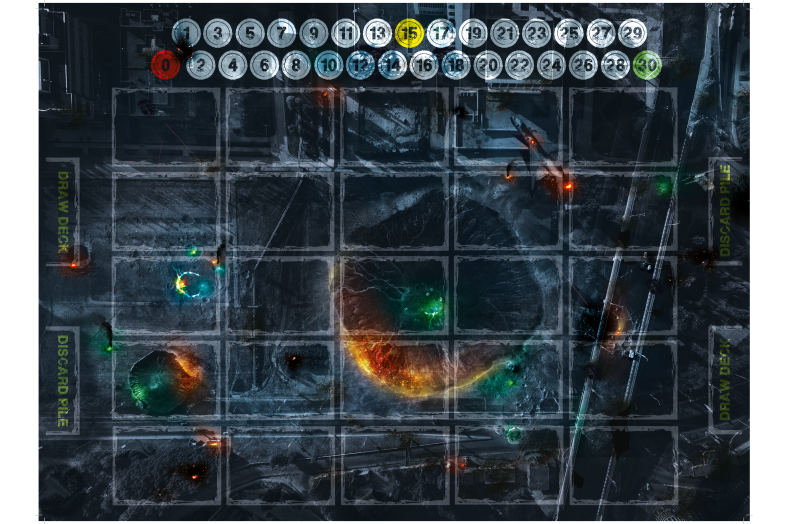
- Basic setup of game board
- Source indicator
- Battleground (5x5 spaces)
- Draw deck
- Discard pile
Key Rules
This chapter gives a basic overview of the rules for an easier understanding of the game.
Golden Rule
In the event of contradiction between the card text and rules, the text on the card always takes precedence.
Winning and Losing
The first player to acquire 30 sources, or force their opponent to lose all their sources, wins the game immediately.
Notice: In the case of the “Artifact game” or “Two on two game” variants see chapter 8 on Game variants on page 14.
Playing Cards
For most played units, locations and events it is necessary to pay the appropriate amount of sources, indicated by their price (red price). This is done by moving the Source Token on the source indicator. At the start of the game, both players have 15 sources each.
Notice: There are also cards whose playment does not cost any sources (red-green price) or which add to the player’s sources (green price).
The playing of cards is primarily directed by the player whose turn it is at present but event cards can be played as a response to actions caused by the opponent, for example to cancel an event card, ability, etc.
Obtaining and Losing Sources
Sources are not just important for playing cards or achieving the winning target, but at the same time they represent the remaining number of player’s lives that must not fall to zero. Sources can be gained/lost during the game in several ways:
- Every combat won against an opposing unit is rewarded by 2 sources, while the opponent loses 2 sources (see the Battle phase on page 11).
- By removing an opposing unit/location from the battleground and moving it to the opponent’s Discard pile or hand, gain sources equal to the cost of that card.
- By tactical playment of units and locations on the battleground the player can get sources for superiority over their opponent in every row and column (see the Dominance phase on page 13).
- Card abilities.
Notice: Events or special abilities of the cards which remove opponent’s cards from the battleground by their effect (Kill, Destroy etc.) and move them to the Discard pile or hand, are not rewarded like winning combat, even if they were used in the current combat. The player will not receive any sources for winning combat (and the opponent does not lose sources), but the player will get sources depending on the card cost.
Increasing Attributes and Passive Abilities
All cards have different attributes and abilities that affect the gameplay. Each card finds its use in different circumstances. We recognize:s
- Attributes: ATTACK, DEFENSE and VITALITY.
- Special abilities: Swap, Flip etc. More in the Glossary on page 17.
- Passive abilities: DAMAGE, MOVE, INCOME etc. More in the Glossary on page 17.
Attributes and passive abilities with +X can be raised by using card abilities. For example, a unit with the passive ability MOVE +1, which gets by the special ability MOVE +2 could move 4 spaces in this way.
Ability Evaluation
An imaginary place where the abilities of played cards pile up, called “the Stack” until the final evaluation.
The player can play an event card from their hand or notify that they are using the ability of the unit or location. All these actions enter “the Stack” and the opponent can react with another event card or ability of their unit/location. If they use this ability the event card it goes into “the Stack”, where the first player can respond again. Event cards and abilities pile up until neither player wants to respond.
However, the evaluation proceeds from the top of “the Stack”, that means in the opposite order than that in which the event cards/abilities were played. The most recently used are evaluated first and may modify, redirect or cancel an event/ability that was played before.
Game Preparation
Perform the following steps before the start of each game of HOPE Cardgame:
- Game board arrangement
- Place the game board in a way to be within the reach of both players.
- Put both Source tokens on number 15 on the source indicator.
- Put Blood glass counters and Target tokens near the game board.
- Deck select
- Specify which player will start the game by throwing the Survival coin.
- The same player has the choice to select the deck first.
- Deck shuffle
- Shuffle the deck and put it on the Draw deck on the game board. The deck thus becomes the Draw deck.
- Starting cards in hand
- Draw 6 cards from your Draw deck.
- Mulligan (optional)
- If you are not satisfied with the drawn cards, you can shuffle some of them in your deck and draw the same amount of cards back into your hand. You then have to keep these 6 cards.
At this moment may the game begin.
Round Sequence
Each game round is divided into 6 phases. Every phase is played by both players in succession and is started by the player who is in possession of the Survival coin. The order of all the phases is indicated on the reference card.
- Order of individual phases:
- Main
- Move
- Explore
- Explore
- Dominance
- Draw
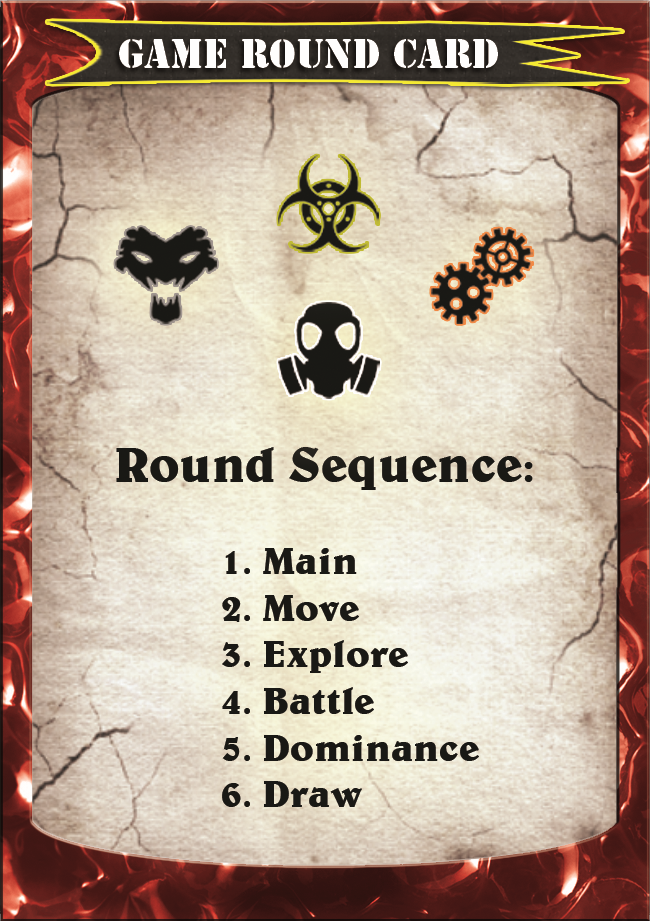
Phase 1: Main
- Playing units on the battleground.
- Playing events with MAIN and ANYTIME flags.
Playing Units
In the first phase players play units to their own home base or on free spaces adjacent to their own locations(see playing locations on page 11) – diagonals are not valid. Players are not limited by the amount of playing units, but current amount of sources.
During the Main phase players can discard any duplicate card of a unique unit which they have played on the battleground into the Discard pile. One wound from the given unit may be healed for each card discarded in this way. This effect does not cost any sources.
obrázek možnosti hraní jednotek na herní plán
Green spaces show the possibilities for playing the units of the player on the left side into his home base or next to his location.After both players have completed all their actions, the Main phase ends and the game enters the Move phase.
Phase 2: Move
- Move up to three units across the battleground.
- Playing events with MOVE and ANYTIME flags.
Unit Movement
Each player can move up to three units across battleground.Each unit can move one space, or even more spaces, when it has (or gains) the passive ability MOVE +X. See more in the Glossary on page 17.
Units can move forward, backward, left or right on the battleground, but they can never move diagonally!
- Other rules of movement:
- Units can only move onto free spaces.
- Units cannot move through spaces occupied by opponent units or locations.
- No unit can be moved more than once in this phase unless an event or special ability says otherwise.
- Units cannot move outside the game board.
- Units can move through their owner's units and locations, but cannot stop on these spaces. For such a move passive ability MOVE +X is needed.
- Locations cannot be moved.
obrázek pohybu křížem
Arrows show the basic movement of units across the battleground in four directions.obrázek zvýšeného pohybu
Arrows show the movement of units with the passive ability MOVE +X.After both players have completed all their actions, the Move phase ends and the game enters the Explore phase.
Phase 3: Explore
- Playing locations on the battleground.
- Playing events with the ANYTIME flag.
Location Explore
This phase enables the exploration of locations on the battleground (see Locations on page 4). During the Explore phase players can play locations on the battleground areaon free spaces adjacent to their own units – once again diagonals are not permitted. Just as with playing units on the battleground, players are not limited by the amount of playing locations, but current amount of sources.
Notice: Locations cannot be played in their owner’s home base.
After both players have completed all their actions, the Explore phase ends and game enters the Battle phase.
obrázek znázorňující hraní lokací
Green spaces show the possibilities for playing locations that cannot be played in the owner’s home base (red).Phase 4: Battle
- Initiating up to three combats.
- Playing events with the flag COMBAT – a specific unit or location must be actively involved in combat (either attacking or defending) and ANYTIME.
Resolving Combats
In the Battle phase each player can initiate up to 3 combats against opponent units and locations.
Individual combats are resolved one after another in the order determined by the player using Target tokens. Each combat must be completely resolved before the next begins. After the first player has initiated and resolved all of their combats, the opponent may then initiate their combats.
- Each combat must contain the following steps:
- Declare target. The attacking player chooses an enemy unit or location, and puts a Target token with the corresponding number on it. It is not possible to mark the same target more than once.
- Declare attackers. The attacking player then declares all available attackers that have the target in sight, i.e. adjacent units – again, no diagonals – or units with the passive ability RANGED. See more in the Glossary on page 17.
- Resolve. Deal damage equal to the attacker’s damage value (see DAMAGE +/- on page 17) or destroy a location.
Depending on the target combat, proceeds attack against units and locations in a different way.
Notice: If a player wants to use the ability of a unit identified as COMBAT, this unit must be involved in an active combat (either attacking or defending).
Fighting Against Units
The sum total ATTACK value of all attacking units is called the total attacking power. The sum total DEFENSE value of the defending unit is called the total defending power. The total attacking and defending power can also be increased by events and/or special abilities.
- If the total attacking power is greater than the defending power, the defending unit receives one wound in the form of a Blood glass counter. Once the unit has the same number of wounds as its vitality (number of Blood glass counters = vitality), it is killed. After that, this unit is removed from the battleground and moved to the Discard pile of the defending player. The attacker receives X sources, where X is the source cost of killed unit.
- If the total attacking power is several times greater than the defending power (see Overwhelm on page 18), the defending unit is killed immediately and it doesn’t matter how many lives it has. After that, this unit is removed from the battleground and moved to the Discard pile of the defending player. The attacker receives X sources, where X is the source cost of killed unit.
For every combat won in this way the attacker gains 2 sources and the defender loses 2 sources.
If the result of the combat is a tie, no one gains or loses any sources.
Notice: In the event that any of the attacking (defending) units has the passive ability FEROCITY (see more in the Glossary on page 17), the attacking (defending) player wins this combat. The attacking player gives the appropriate number of wounds to the defending unit. The attacker gains 2 sources and the defender loses 2 sources.
If the total defending power is greater or several times greater than the total attacking power, the defender successfully defends against the attacker and no one gains any sources.
Fighting Against Locations
The sum total ATTACK value of all attacking units is called the total attacking power. The sum total DEFENSE value of the defending location is called the total defending power. The total attacking power can also be increased by events and/or special abilities.
- If the total attacking power is same or greater than the total defending power, the location is destroyed. After that, the location is removed from the battleground and moved to the Discard pile of the defending player. The attacker receives X sources, where X is the source cost of the destroyed location.
- If the total attacking power is less than the defending power, the location is not destroyed or damaged.
For destroying a location the attacker does not receive 2 sources and the defender does not lose 2 sources, as in the case of combat between units.
- Combat exceptions:
- The attacker cannot attack through opponent units or any non-flipped locations.
- The attacker can attack through their own units without any negative effects.
- The player with the smaller total ATTACK/DEFENSE value always plays events first.
- The player with the smaller total ATTACK/DEFENSE value always plays events first.
After both players have completed all their actions, the Battle phase ends and game enters the
obrázek útoku přes vlastní jednotku a lokaci
With the passive ability RANGED it is possible to attack through your own units, but not through opponent units or any non-flipped locations.Phase 5: Dominance
- Evaluation of dominance on the battleground and counting income.
- Playing events with the ANYTIME flag.
Counting Income
The Dominance phase represents a measure of the forces on the battleground, which is based on counting the income from the dominance on the battleground.
Both players gradually compare the number of their units and locations in each column and each row. Locations have greater relevance in the Dominance phase than units, therefore they are counted as two units.
For each column and row where the player has dominance over an opponent, the player gets one source. In the event of a tie nobody gets a source. Without the passive ability INCOME (see Glossary on page 17), therefore, both players divide up to 10 sources between them.
Notice: During the evaluation of the Dominance phase, card attributes (e.g. Source cost, ATTACK value…) do not depend on the battleground, but on their amount.
TIP: The Dominance phase is very important for obtaining sources. Players must be very careful with the arrangement of units and locations during the game, for example as early as the Move phase. Sources acquired in the Dominance phase are important especially for playing new units in the Main phase of the next round, or to obtain 30 victorious sources.
obrázek počítání dominance
Orange player controls rows 1, 2 and column B; gains 3 sources. Blue player controls rows 3, 5 and columns C and D. In column C the player has a unit with the passive ability INCOME +1 and gains a total of 5 sources. Row 4 and column A, E end in a draw and no one gains any source. After both players have completed all their actions, the Dominance phase ends and the game enters the Draw phase.Phase 6: Draw
- Playing events with the ANYTIME flag.
- Discarding unnecessary cards from the hand to the Discard pile, drawing new cards to make six and passing the Survival coin to an opponent.
Drawing Cards
In the last phase, players can discard any number of cards into the Discard pile and draw more from the Draw deck to make six.
If players have more than six cards in their hand, they must discard cards until they have a maximum of 6.
If players have no remaining cards in their Draw deck, it is not possible to draw any other card and the game will continue with the remaining cards in the game.
After both players have completed all their actions, the Draw phase ends. The first player then passes the Survival coin to the next player and the game enters the Main phase of the next game round. The player who has the Survival coin starts all phases of this round.
Game Variants
In addition to the basic option "Game one on one", players can also choose variant "Artifact game" or "Two on two game".
Artifact Game
At the beginning of the game players will randomly choose 5 Artifact tokens and place them face down on the five spaces of the middle row of the battleground. The abilities will therefore be kept secret until the last moment.
When a unit enters a space with the artifact, the player turns the token facing up and the unit gets – according to the characteristics of the artifact – either a positive or negative ability.
Notice: Players cannot play locations on spaces with artifacts.
If the unit moves, it always takes the artifact with it. Units with artifacts may move standardly and artifact abilities affect them until they are removed from the battleground. A single unit may bear all five artifacts.
Notice: No unit can discard artifacts until it is removed from the battleground..
Once the unit bearing the artifact is removed from the battleground, the artifact stays on the last space.
A player wins at the moment when the player controls three or more artifacts at the end of the game round. In this type of game the rule that a player wins the game by gaining 30 or more sources does not apply, but the rule remains that a player with 0 or fewer sources loses the game.
- ACCURACY IMPLANTS: The source cost of each event played during the Battle phase involving the bearer is -1 (max. 0).
- ANCIENT BAG: When a unit takes this artifact from the battleground, its bearer may draw a card..
- DISEASE: The source cost of each event played during the Battle phase involving bearer is +1.
- FOOD CRATES: When a unit takes this artifact from the battleground, its bearer gains 2 sources.
- NEVERENDING PAIN: When a unit takes this artifact from battleground, its bearer must discard a card from their hand.
- WRACKED SUPPLIES: When a unit takes this artifact from the battleground, its bearer loses 2 sources.
Two on Two Game
The basic version of HOPE Cardgame includes one game board allowing a game for two players. However, with the purchase of an additional game, an additional game board, or its printing from the website www.hopecardgame.com, it is possible to play in cooperative gaming mode “Two on two game”.
At the beginning of the game, the four players are divided into two teams of two and place 2 game boards with the longer columns together, so as to be accessible by all players.
General Changes
The first team to accumulate any combination of 40 sources or steal the other team’s sources wins the game.
Notice: The source indicator has a maximum of 30 sources To indicate more sources put the Blood glass counter on your source token and continue from number 1 on the source indicator.
Players of both teams take turns during the game according to the following schedule.
| 1st round | team 1 player 1 | team 2 player 1 | team 1 player 2 | team 2 player 2 |
|---|---|---|---|---|
| 2nd round | team 2 player 1 | team 1 player 2 | team 2 player 2 | team 1 player 1 |
| 3rd round | team 1 player 2 | team 2 player 2 | team 1 player 1 | team 2 player 1 |
| 4th round | team 2 player 2 | team 1 player 1 | team 2 player 1 | team 1 player 2 |
Tip: We recommend playing with different races, or putting cards into different colored packages so the cards will be easily recognizable by teammates on the common battleground.
Notice: The "You" in text on cards relates only to players who own this card, not both teammates.
By joining both game boards, an integrated battleground in the size of 10 columns and 5 rows is created, where units of all players can move and combat normally.
Changes in Phases
- Main
- Both teammates can play units in their common home base, as well as around locations under their control.
- Move
- With the passive ability MOVE +X it is possible to move through your teammate’s units.
- Units can move from one far side of battleground to the other.
- Explore
- Locations can also be played next to the teammate’s units.
- Battle
- Your teammate’s units can participate in combats (when attacking) together.
- Attacking teammate whose turn it isn’t can affect combat using the abilities of involved units and playing event cards.
- Units can attack from one far side of battleground to the other.
- Notice: It is prohibited to initiate combats between teammates!
- Dominance
- Victory points from the dominance in rows and columns are counted together for each team. After that teammates will split these sources between them by their agreement.
- The Draw phase is unchanged.
When your partner is destroyed (their sources reach 0 or less) the player must discard all of their remaining cards, and remove their Draw deck and Discard pile from the game board. This player is now out of the game.
Deck Customization
It is possible to enjoy HOPE Cardgame with the pre-defined decks in this core set, but the greatest joy of the game lies primarily in customizing your own deck and competing in official tournaments.
Once players gain enough experience, know the game mechanics and learn how to properly use all the game cards, they may wish to find another way to fully enjoy the game – by constructing their own decks according to preferred tactics and strategies.
The following rules are used to create custom decks on official tournaments and to exploit all the possibilities that HOPE Cardgame offers.
Deck Customization Rules
Units always refer to a specific race. To create a custom deck it is possible to choose either one or two friendly races (eg. Humans can be combined with Bots, or Mutants – see Races diagram).
Locations and events are always neutral and can be used in a deck in connection with any races.
- Each deck must include:
- units from the chosen races
- up to 2 copies of any unit
- up to 2 copies of any location
- up to 2 copies of any event
- exactly 36 cards.
- Recommendation for creating a deck:
- at least 18 or more units
- at least 4 or more locations.
Notice: It is possible to play the game casually with decks of other sizes and specifications as long as all players have customized their decks under the same set of guidelines.
obrázek diagramu ras
Races DiagramGlossary
Passive Abilities
DAMAGE +/- X
DAMAGE +/- adds/subtracts the number of wounds which the attacking unit grants to the opposing unit in combat. If the overall DAMAGE of the attacking unit is negative, the unit does not deal any wound.

